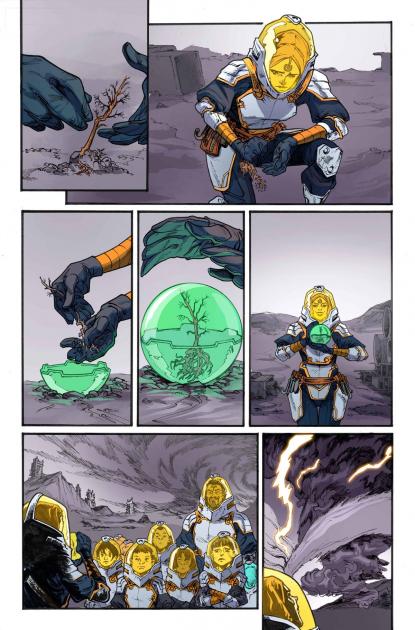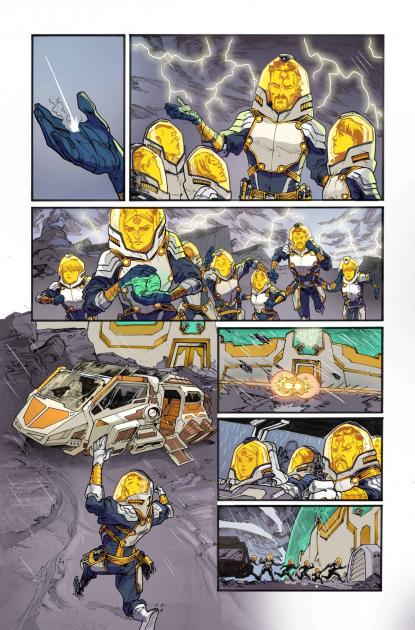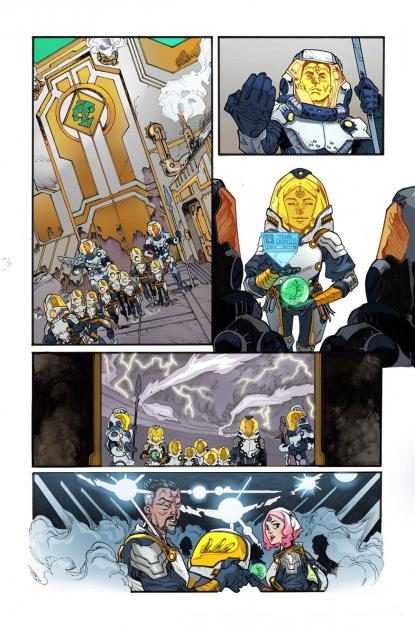Interview with Emily Horn, Writer of No One's Rose
I recently got the chance to talk to Emily Horn about the release of No One's Rose next month. An experienced writer, No One's Rose marks her debut entry into the world of comics. Co-written with Zac Thompson (Click here for our interview with him), illustrated by the talented Alberto Alburquerque, with colours by Raul Angulo and letters by Hassan Otsmane-Elhaou.
No One's Rose is a genre of sci-fi called Solar Punk. It's filled with some incredible concepts and ideas. Not only that but it's exciting, relevant to issues which affect us today, and unusually for a story of its type it's also filled with hope.

Hi Emily. I appreciate you taking the time to talk to CTG about No One's Rose. I really enjoyed the first issue and the vision that you and Zac have painted of the future. There are a number of fantastic ideas and original concepts in this first issue. This feels like a much more optimistic post-apocalypse story than most we read.
You’ve been generous enough to share an early review copy of No One’s Rose #1 with me, but how would you sum it up for our readers who don’t know what to expect?
No One’s Rose #1 takes place in the future on Earth, centuries after runaway climate change inside of the Green Zone, a completely ecologically sustainable city, protected from superstorms and toxic air by an energy field dome. The city is a human experiment gone right, and people have lived peacefully within this little utopia for centuries. But over time people have found themselves living in completely different worlds within the same city, divided by their professions. The farmers are stuck living on the lower levels, and the bureaucrats and high ranking officials live at the top. Tenn is a successful bio-engineer with a bright future in the upper levels, and her brother Seren is stuck in a go nowhere career on the lower levels shovelling waste. This growing divide is tearing their relationship apart, and Seren is growing angrier every day. He wants change and he’s reaching his tipping point to make it happen in this issue.
You’ve described this book as Solarpunk. That wasn’t a term I’d come across before and had to google it. How would you explain it in your own words?
Solar Punk envisions what a radically different, peaceful and ecologically sustainable society would look like. Generally anti-capitalist. Basically Solar Punk to me is the anti “Mad Max” vision of the future. One where humans collaborate to build sustainable, beautiful, green cities on Earth.
There are a lot of great concepts and worldbuilding in that first issue. You manage to tread that fine line between introducing all these new concepts but still telling the story. How much of a challenge is it to introduce all these new concepts without just being a massive info dump?
Hoo boy. We spent a lot of time on issue #1 to make sure that we were balancing those aspects. Comic pacing moves fast so we tried to reveal only as much as was important for the story as it progressed in dialogue. We also use a fair bit of inner monologue which has been a great tool for revealing more about our characters and the world. A lot of the worldbuilding happens in the imagery itself, which Alberto Alburquerque did an incredible job of bringing to life.
One of the themes I notice both of you talking about a lot in relation to No One’s Rose is hope. Was that a conscious decision from the start? Or did it develop along the way?
This was a conscious decision on our part from the beginning, and one that we try to stay true to throughout the story. I am personally exhausted with dystopian stories about growing surveillance states, privacy loss, resource wars, etc. We wanted to build something that was full of light, something that showcased a society, no matter how small, that learned how to live sustainably and in harmony.
However, because we also wanted to address the seriousness of the climate emergency it is set in a pretty bleak vision of the future on Earth. It highlights how important and precious this utopian society is. Of course, no society is perfect so we see growing social unrest in the dome as well. You need shit disturbers to keep your governing bodies honest, otherwise bureaucracy starts to take over in dangerous ways.
There is obviously a lot of work that’s gone into the worldbuilding in this series and practical solutions to the problems the people in the comic face. Are there aspects of this worldbuilding which won’t make its way into the comics?
I’m glad you asked! In fact, we have a ridiculously giant story “bible” that has all the elements of worldbuilding which we have been working on. There is a future story and backstory beyond this five issue series which we really hope to be able to tell in one way or another, but which doesn’t really fit in this overall plot.
This is your first time writing a comic. How did you find the process?
I have written a lot of articles, short stories and scripts for various projects but yes this was the first comic I’ve written. I was familiar with the process of writing comics because I edited “The Replacer,” Zac’s creator owned horror graphic novella at Aftershock.
I have to say that actually writing a comic was incredibly eye opening and I honestly have so much respect for comic writers, artists, colourists and letterers after this process. There is something magical about taking an idea, sharing it with a group of people, and collaborating on it to bring it to life. Everyone has their own perspective on how the world should look and feel, and I couldn’t have been luckier when it comes to the collaborators on this project (Alberto Jimenez Alburquerque on art, Raul Angulo on colours, Hassan Otsmane-Elhaou doing lettering).
It’s a powerhouse group of creators, and I’m very aware that I’m the odd (wo)man out on this project. Comic creation is a really difficult and underrated craft and I just feel lucky that I am able to learn and work with these guys. The one thing I find particularly tricky is saying as much as possible with as few words as possible. There really is an incredible economy to writing comics, it is almost like writing poetry in that way.
Do you plan to write any more comics in the future? Or is there anything already in the works?
Yes! Definitely. I have a few ideas percolating, but none in the works now. I’m performing a juggling act right now because I’m doing my master’s degree as well as writing this series so once I have some more breathing room I would absolutely love to. I’d actually love to write more of No One’s Rose because I think the main characters have a lot of exciting adventures ahead of them.
How was it collaborating with Zac?
Anyone who has worked with Zac knows that he is an incredible collaborator, and despite all of the colourful Wrangler cowboy shirts he’s a consummate professional. He’s insanely hard working and passionate which really makes the book a joy to work on with him. He’s also obviously a really talented writer, so I’ve learned a lot in the process. One thing I have to say is that he has the wildest imagination of anyone I’ve ever met, and that shows in all of his work. Sometimes we come at a scene or a plot point from completely different angles and I think that friction ends up creating something we both never expected, and are both really proud of.
Thank you for taking the time out of your busy schedule to talk with us. Pre-order No One's Rose #1 here. Check out our review for #1. Find a preview of the first five pages below:





No One's Rose is a genre of sci-fi called Solar Punk. It's filled with some incredible concepts and ideas. Not only that but it's exciting, relevant to issues which affect us today, and unusually for a story of its type it's also filled with hope.

Hi Emily. I appreciate you taking the time to talk to CTG about No One's Rose. I really enjoyed the first issue and the vision that you and Zac have painted of the future. There are a number of fantastic ideas and original concepts in this first issue. This feels like a much more optimistic post-apocalypse story than most we read.
You’ve been generous enough to share an early review copy of No One’s Rose #1 with me, but how would you sum it up for our readers who don’t know what to expect?
No One’s Rose #1 takes place in the future on Earth, centuries after runaway climate change inside of the Green Zone, a completely ecologically sustainable city, protected from superstorms and toxic air by an energy field dome. The city is a human experiment gone right, and people have lived peacefully within this little utopia for centuries. But over time people have found themselves living in completely different worlds within the same city, divided by their professions. The farmers are stuck living on the lower levels, and the bureaucrats and high ranking officials live at the top. Tenn is a successful bio-engineer with a bright future in the upper levels, and her brother Seren is stuck in a go nowhere career on the lower levels shovelling waste. This growing divide is tearing their relationship apart, and Seren is growing angrier every day. He wants change and he’s reaching his tipping point to make it happen in this issue.
You’ve described this book as Solarpunk. That wasn’t a term I’d come across before and had to google it. How would you explain it in your own words?
Solar Punk envisions what a radically different, peaceful and ecologically sustainable society would look like. Generally anti-capitalist. Basically Solar Punk to me is the anti “Mad Max” vision of the future. One where humans collaborate to build sustainable, beautiful, green cities on Earth.
There are a lot of great concepts and worldbuilding in that first issue. You manage to tread that fine line between introducing all these new concepts but still telling the story. How much of a challenge is it to introduce all these new concepts without just being a massive info dump?
Hoo boy. We spent a lot of time on issue #1 to make sure that we were balancing those aspects. Comic pacing moves fast so we tried to reveal only as much as was important for the story as it progressed in dialogue. We also use a fair bit of inner monologue which has been a great tool for revealing more about our characters and the world. A lot of the worldbuilding happens in the imagery itself, which Alberto Alburquerque did an incredible job of bringing to life.
One of the themes I notice both of you talking about a lot in relation to No One’s Rose is hope. Was that a conscious decision from the start? Or did it develop along the way?
This was a conscious decision on our part from the beginning, and one that we try to stay true to throughout the story. I am personally exhausted with dystopian stories about growing surveillance states, privacy loss, resource wars, etc. We wanted to build something that was full of light, something that showcased a society, no matter how small, that learned how to live sustainably and in harmony.
However, because we also wanted to address the seriousness of the climate emergency it is set in a pretty bleak vision of the future on Earth. It highlights how important and precious this utopian society is. Of course, no society is perfect so we see growing social unrest in the dome as well. You need shit disturbers to keep your governing bodies honest, otherwise bureaucracy starts to take over in dangerous ways.
There is obviously a lot of work that’s gone into the worldbuilding in this series and practical solutions to the problems the people in the comic face. Are there aspects of this worldbuilding which won’t make its way into the comics?
I’m glad you asked! In fact, we have a ridiculously giant story “bible” that has all the elements of worldbuilding which we have been working on. There is a future story and backstory beyond this five issue series which we really hope to be able to tell in one way or another, but which doesn’t really fit in this overall plot.
This is your first time writing a comic. How did you find the process?
I have written a lot of articles, short stories and scripts for various projects but yes this was the first comic I’ve written. I was familiar with the process of writing comics because I edited “The Replacer,” Zac’s creator owned horror graphic novella at Aftershock.
I have to say that actually writing a comic was incredibly eye opening and I honestly have so much respect for comic writers, artists, colourists and letterers after this process. There is something magical about taking an idea, sharing it with a group of people, and collaborating on it to bring it to life. Everyone has their own perspective on how the world should look and feel, and I couldn’t have been luckier when it comes to the collaborators on this project (Alberto Jimenez Alburquerque on art, Raul Angulo on colours, Hassan Otsmane-Elhaou doing lettering).
It’s a powerhouse group of creators, and I’m very aware that I’m the odd (wo)man out on this project. Comic creation is a really difficult and underrated craft and I just feel lucky that I am able to learn and work with these guys. The one thing I find particularly tricky is saying as much as possible with as few words as possible. There really is an incredible economy to writing comics, it is almost like writing poetry in that way.
Do you plan to write any more comics in the future? Or is there anything already in the works?
Yes! Definitely. I have a few ideas percolating, but none in the works now. I’m performing a juggling act right now because I’m doing my master’s degree as well as writing this series so once I have some more breathing room I would absolutely love to. I’d actually love to write more of No One’s Rose because I think the main characters have a lot of exciting adventures ahead of them.
How was it collaborating with Zac?
Anyone who has worked with Zac knows that he is an incredible collaborator, and despite all of the colourful Wrangler cowboy shirts he’s a consummate professional. He’s insanely hard working and passionate which really makes the book a joy to work on with him. He’s also obviously a really talented writer, so I’ve learned a lot in the process. One thing I have to say is that he has the wildest imagination of anyone I’ve ever met, and that shows in all of his work. Sometimes we come at a scene or a plot point from completely different angles and I think that friction ends up creating something we both never expected, and are both really proud of.
Thank you for taking the time out of your busy schedule to talk with us. Pre-order No One's Rose #1 here. Check out our review for #1. Find a preview of the first five pages below:





Comments
- Nick Devonald's blog


